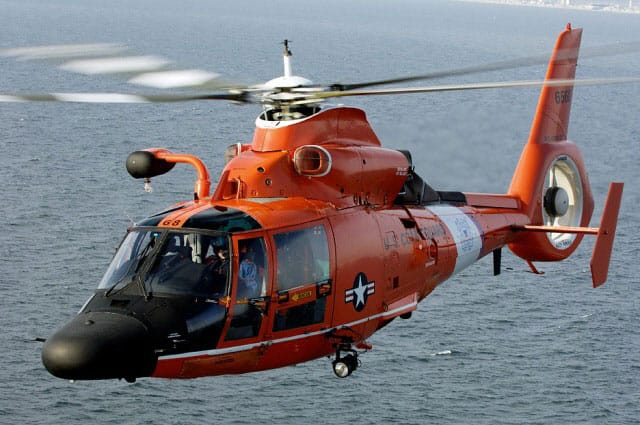By John Moseley, CGAA Historian

In August of 2002, during the ceremony making the contract award for the Integrated Deepwater System, (IDS), Coast Guard Commandant Admiral Thomas H. Collins described the critical need to upgrade and modernize the service’s force of cutters, aerial platforms, and support systems.
With the contract awarded to Integrated Coast Guard Systems (ICGS)—a joint venture between Northrop Grumman and Lockheed Martin—the plan to implement the transformation of Coast Guard aviation was set in motion. It encompassed the progressive upgrading of selected legacy assets and the introduction of new and more capable fixed-wing aircraft, helicopters, and unmanned aerial vehicles (UAVs).
Deepwater was a unique system-of-systems approach to fulfill this requirement. Execution became a significant problem. The Coast Guard set the performance requirements for the program but allowed the contractor, ICGS, to assume responsibility for designing, building and integrating the systems. Oversight by the Coast Guard was minimal and in general, expertise of Coast Guard personnel was considered secondary to that of private contractors.
Aviation forces fared better than surface forces under Deepwater because there was a deliberate effort on their part to monitor, evaluate, suggest and make their opinions and conclusions known to Integrated Deepwater System Program (IDS) managers. The HH-65C engine replacement is atypical of actions taken by the Aviation Aeronautical Community.
There were 95 HH-65 airframes in the 2002 inventory and due to its composite construction, unlike other Coast Guard platforms, it has no airframe service life. As a result, it was decided to invest in the fleet of HH-65s with a Service Life Extension Plan (SLEP) that would yield a like-new aircraft as the Multi-Mission Cutter Helicopter. The upgrade was scheduled in phases. An Avionics retrofit had been undertaken in 2001. It consisted of a Night Vision Goggle (NVG) compatible integrated flight management avionics suite consisting of two GPS-embedded CDU-900G control display units and two MFD-255 multifunction flat panel displays.
Since its introduction in 1984, the HH65, powered by the LTS101-750 engine, experienced a variety of engine problems. The problem initially was with the core engine and in the 2003-2004 time period the number of reported power losses and incidents had grown dramatically. In fiscal 2003 pilots had reported 32 incidents and in the 7 month period from October 2003 to 1 March 2004, there were 67 incidents reported.
The degraded safety and reliability of the HH-65A/B powerplant forced the Coast Guard to make improvement of the powerplant the number one priority of Coast Guard Aviation. The deepwater people initiated a project to replace the LTS101-750 with a model 850. This was not going to work and the aviation forces knew it. Time critical, a decision had been made by aviation forces to initiate a sustaining engineering project (a way to initiate a study and obtain a satisfactory engine upgrade outside of Deepwater) utilizing Turbomeca Arriel 2C-1/2 engines, on Coast Guard HH-65 #6560 at the Coast Guard’s Aircraft Repair and Supply Center in Elizabeth City, NC. The engine had been proven on the Eurocopter EC 155 and could be installed on the HH-65 with no structural adaptation. An HH-65 was flown with Arriel 2C2 engines in the summer of 2003 and it proved to be an excellent match. Subsequent testing and evaluation identified this engine as a solution to the HH-65A/B engine failure/power decrease problem.
Aviation forces fared better than surface forces under Deepwater because there was a deliberate effort on their part to monitor, evaluate, suggest and make their opinions and conclusions known to Integrated Deepwater System Program (IDS) managers. The HH-65C engine replacement is atypical of actions taken by the Aviation Aeronautical Community.
Captain “Jake” Korn, well qualified in all aspects, led three study groups on the future of Coast Guard Aviation, which set the near term strategic direction for the Coast Guard’s aviation fleet. The first dealt with the requisites to enable the Fixed Wing fleet to meet all the CG’s requirements. The second dealt with the requisites to enable the Rotary Wing fleet to meet all the CG’s requirements. The third identified what was needed to make the then-current (2004) Aviation fleet last another 20 years in case the Deepwater Program proved not to be successful. Captain Thomas C. King, Chief Aviations Forces, used results of these studies and inputs From Captain Barry Harner, Chief of Aviation Engineering, Captain Mark Butt and Paul Garrity as the basis in his attempts to effectively deliver the capabilities needed to execute the full range of missions. Of utmost importance were the efforts of RADM Dave Belz, the Assistant to the Commandant for Operations with responsibilities that included oversight of a wide range of Coast Guard missions. On numerous occasions he forcefully and effectively presented the views of the Aviation Forces.
The aviation forces prevailed. The engine change would remain in the ICGS program. However, American Eurocopter provided 2C2 re-engineering kits and the engine changes were performed by AR&SC on an expedited schedule, at reduced cost, and sustained high quality workmanship was obtained. To expedite the schedule engine replacement 16 aircraft were re-engined at the new American Eurocopter facility in Columbus Mississippi.
Captains King and Harner took a great deal of heat from RADM Stillman as well as political pressure but prevailed and the HH-65D became an outstanding aircraft.
In 2007 the Coast Guard replaced the single integrated Deepwater acquisition program with an Acquisition Directorate that retained a systems outlook by employing Coast Guard program managers who have purview over a portfolio of related projects within their domains. Aviation finally won one!
The upgrade to HH-65C included the installation of a 10 blade low-noise Fenestron, relocated avionics and an Airborne Use of Force (AUF). In early 2008 the HH-65C replaced the Agusta MH-68A as the aircraft used by the Coast Guard Helicopter Interdiction Squadron (HITRON).
In 2011 the aircraft was again upgraded and designated MH-65D. It was fitted with a radar altimeter, two imbedded GPS inertial navigation systems and two control display units.
John Bear Moseley
CGAA Historian

